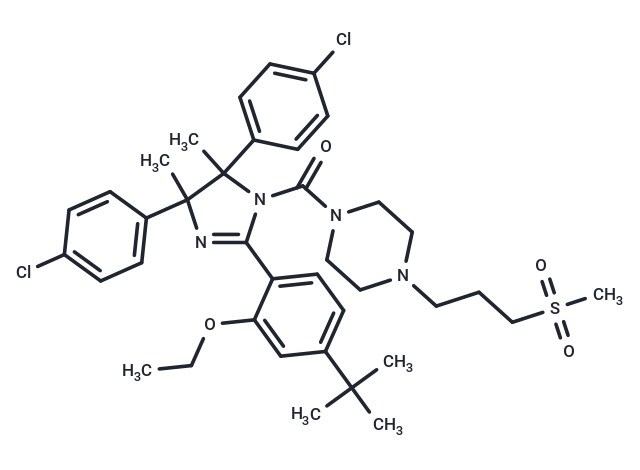Shopping Cart
- Remove All
 Your shopping cart is currently empty
Your shopping cart is currently empty

RG7112 (RO5045337) (RO5045337) is an orally bioavailable and selective p53-MDM2 inhibitor.

| Pack Size | Price | Availability | Quantity |
|---|---|---|---|
| 1 mg | $41 | In Stock | |
| 2 mg | $59 | In Stock | |
| 5 mg | $97 | In Stock | |
| 10 mg | $172 | In Stock | |
| 25 mg | $343 | In Stock | |
| 50 mg | $522 | In Stock | |
| 100 mg | $756 | In Stock | |
| 500 mg | $1,580 | In Stock | |
| 1 mL x 10 mM (in DMSO) | $157 | In Stock |
| Description | RG7112 (RO5045337) (RO5045337) is an orally bioavailable and selective p53-MDM2 inhibitor. |
| Targets&IC50 | MDM2:11 nM(Kd) |
| In vitro | In three wild-type p53 (HCT116, RKO, and SJSA1) cell lines, RG7112 selectively and dose-dependently inhibits cell growth. In cancer cells expressing wild-type p53, RG7112 activates the p53 pathway, and induces cell-cycle arrest and apoptosis. RG7112, both alone and combined with Peg-IFNα 2a, significantly decreases MPN colony-forming unit-granulocyte macrophage and burst-forming unit-erythroid numbers and preferentially eliminates the total number of JAKV617F(+) MPN hematopoietic progenitor cells. In addition, in MDM2-amplified liposarcoma cells, RG7112 significantly synergizes with Trabectedin. |
| In vivo | In rats, RG7112 impairs thrombopoiesis via activation of p53. In the SJSA1 xenograft mouse model, RG7112 (200 mg/kg, p.o.) penetrates tumor cells and activate p53 and its 2 major functions, cell-cycle arrest and apoptosis. In nude mice bearing SJSA-1, and MHMn xenografts, RG7112 (100 mg/kg, p.o.) causes tumor regression. |
| Kinase Assay | HTRF assay: Homogeneous time-resolved fluorescence (HTRF) assay measures the signal generated by 2 components when they are in close proximity. The p53–MDM2 binding assay uses a biotinylated peptide derived from the MDM2-binding domain of p53 and a truncated N-terminal portion of recombinant human GST-tagged MDM2 protein containing the p53-binding domain. Proteins for crystal structure studies are expressed in E. coli strain BL21 using the helper plasmid pUBS 520 coding for the lacIq repressor and the rare tRNAArg [AGA/AGG]. For crystallization, the frozen protein is thawed and concentrated to 9.8 mg/mL using a Centricon concentrator (3,000 MW cutoff). The complex is then formed by combining the protein with a slight molar excess of the inhibitor (stock solution is 100 mM in DMSO) and this solution is allowed to sit for 4 hours at 4°C. Cryopreserved crystals are used to collect diffraction data on beamline X8C at the National Synchrotron Light Source at Brookhaven National Laboratory. |
| Cell Research | Cell lines: Three wild-type p53 (HCT116,RKO,and SJSA1) and 2 mutant p53 (SW480 and MDA-MB-435) cell lines. Concentrations: ~5 μM. Incubation Time: 5 d. Method: Cell proliferation/viability is evaluated by the tetrazolium dye (MTT) assay.Cell growth kinetics are measured using the IncuCyte live cell imaging system.For cell-cycle analysis,cells are cultured in T75 flask with appropriate growth medium (106 cells/condition in 10 mL) and incubated overnight at 37°C.They are incubated with test compounds and processed. |
| Animal Research | Animal Models: Nude mice bearing SJSA-1,MHMn,or LNCaP xenografts. Formulation: Suspended in 1% Klucel LF/0.1% Tween 80. Dosages: ~200 mg/kg. Administration: p.o. |
| Alias | RO5045337, RG-7112, RG 7112 |
| Molecular Weight | 727.78 |
| Formula | C38H48Cl2N4O4S |
| Cas No. | 939981-39-2 |
| Smiles | CCOc1cc(ccc1C1=NC(C)(c2ccc(Cl)cc2)C(C)(N1C(=O)N1CCN(CCCS(C)(=O)=O)CC1)c1ccc(Cl)cc1)C(C)(C)C |
| Relative Density. | 1.23 g/cm3 |
| Storage | Powder: -20°C for 3 years | In solvent: -80°C for 1 year | Shipping with blue ice. | |||||||||||||||||||||||||||||||||||
| Solubility Information | Ethanol: 93 mg/mL (127.79 mM), Sonication is recommended. DMSO: 93 mg/mL (127.79 mM), Sonication is recommended. H2O: < 1 mg/mL (insoluble or slightly soluble) | |||||||||||||||||||||||||||||||||||
Solution Preparation Table | ||||||||||||||||||||||||||||||||||||
Ethanol/DMSO
| ||||||||||||||||||||||||||||||||||||

Copyright © 2015-2025 TargetMol Chemicals Inc. All Rights Reserved.